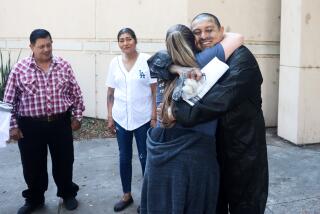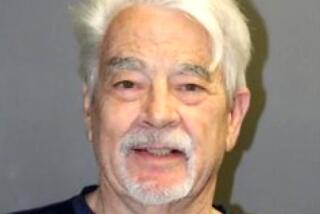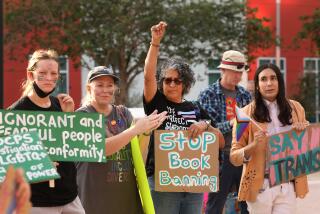Instrument Stirs a Controversy in Court : New Scope Helps Confirm Sexual Abuse
The 18-month-old baby girl allegedly had been sodomized six weeks before Dr. Bruce Woodling, a Ventura family practitioner, examined her. Her acute injuries had healed, but Woodling was able to make a diagnosis of sexual abuse from the scars that remained. Although some were visible to his trained, naked eye, he was able to document still others in a Bakersfield court last week with the help of a special--and controversial--instrument.
The instrument, known as a colposcope, combines a pair of binoculars with a camera on a swiveling stand. It allows physicians to magnify and photograph injuries indicative of sexual abuse without ever touching the body, often while the child lies on the mother’s lap.
Long accepted as a medical tool in the diagnosis of cancers, use of the colposcope in determining whether a child has been molested is new, and likely to become more widespread. Woodling, thought to be the first physician in the United States to use the instrument in such cases, first employed the colposcope about three years ago.
Woodling and his colposcope might have gone unnoticed outside the field of child sexual abuse were it not for the McMartin Pre-School molestation case: The procedure came to the forefront of the protracted preliminary hearing this month when a Los Angeles pediatrician testified that she had used the colposcope--with Woodling’s help--in some of her examinations of more than 150 former students at the Manhattan Beach nursery school, including 34 of the 41 youngsters named as victims in the case.
The physician, Dr. Astrid Heger of County-USC Medical Center and Children’s Institute International, a child abuse diagnostic and treatment center, testified that she found physical evidence of sexual abuse or assault in 29 of those 34. Woodling said he reviewed the cases with Heger, and reached similar conclusions.
Heger testified that the patterns of scarring--their precise location, number, size and shape--and the enlarged body openings she saw would not have been due to self-inflicted injuries or accidents. Rather, she said, they were “consistent with the history of sexual abuse” given by the children. Such scars, she added, can indicate years-old abuse, particularly in young children who are not yet sexually active.
In most instances, she said, the colposcope “amplified” scarring that was already visible to her naked eye, by magnifying it 15 times. It also provided a permanent, detailed record of her exams in three-dimensional slides that can be studied by defense experts without subjecting the child to further examinations.
But defense attorneys in the McMartin case argue that the colposcope’s findings have not been shown to be medically significant and that those few physicians who are trained in interpreting them are biased.
Forrest Latiner, a deputy public defender representing Peggy Ann Buckey, granddaughter of school founder Virginia McMartin, compared the view through the colposcope to a “a Disneyland ride” in which the normal human body looks abnormal because it has been magnified many times.
“Without more study or tests, are you sure that you are seeing sex abuse when such an examination of an unabused child might reveal scars too?” he asked in an interview. He said he opposes colposcopic evidence unless it clarifies what the physician has seen without it, and would accept those findings only if a physician could testify that he had examined at least 1,000 abused and unabused children and found consistent differences.
Another defense attorney, Dean Gits, who represents Peggy McMartin Buckey, daughter of Virginia McMartin, voiced similar concerns: “They (the prosecution) are trying to match scars with complaints, but nobody’s done any studies on what causes them. Both the colposcopic and easily visible scarring might be found in children who haven’t been molested, too.”
Research on the role of the colposcope in detecting child sexual abuse is scanty; the first published report in this country of its use appeared in a 1981 paper by a Brazilian physician. But it has drawn interest from specialists and would probably be more widely used by pediatricians and emergency rooms were it not for a price tag of nearly $8,000. It is being used in several California medical centers and by a handful of universities and private physicians on the East Coast, said Woodling, who is setting up a national study program on the role of the colposcope.
Emergency Room Guide
Woodling, who is chairman of a state Office of Criminal Justice Planning’s medical protocol committee for the evaluation of sexual assault, said his group will recommend colposcopy on all suspected sexual abuse victims, especially children, in a written guide soon to be distributed to hospital emergency rooms throughout California. The instrument is also being considered for use in Los Angeles County’s planned sexual abuse trauma centers.
He said he has examined hundreds of molestation victims and children who have not been sexually abused. “You can see microtrauma in both,” he said, “and they are different.”
Defense efforts to strike medical testimony in the McMartin case, especially that involving Heger’s colposcopic findings, have so far been unsuccessful. But questions about the admissibility of findings obtained with the colposcope and the weight they should carry are far from settled.
Last month, in the first court challenge of the instrument, a California appellate court sent a case involving colposcopic evidence back to the trial court for further hearing on several related issues. The case involved three Panorama City girls who allegedly were molested by their mother’s boyfriend.
In its opinion, apparently the first written mention of the colposcope in a U.S. child abuse case, the appellate court noted that the procedure did not invade the body and thus did not destroy evidence (of innocence). However, it did not rule on the question of its scientific validity.
More to Read
Sign up for Essential California
The most important California stories and recommendations in your inbox every morning.
You may occasionally receive promotional content from the Los Angeles Times.









